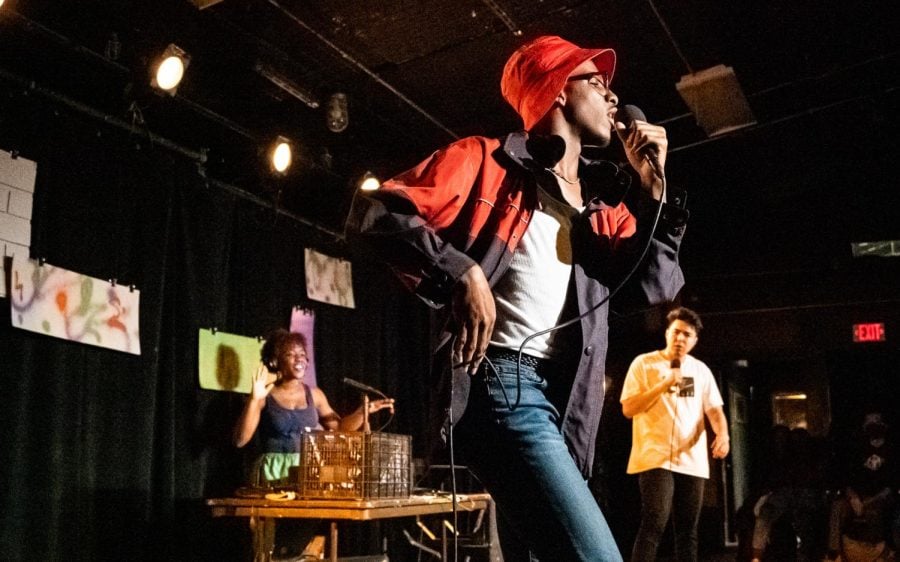NU’s ‘How We Got On’ breathes in the joy of hip-hop in suburbia
Luis Castañeda/The Daily Northwestern
Malik Middleton, as Hank “John Henry” Charles, in the middle of a rap battle against David Garcia Suarez, as Julian “Vic Vicious” Hayes.
April 3, 2023
Navigating high school is already hard enough: Add trying to become some of the best rappers in the Midwest on top of that, and it seems nearly impossible. But the characters of the play “How We Got On” are doing just that.
Set in the 1980s, “How We Got On,” written by playwright Idris Goodwin, is a coming-of-age story following three teenagers in a Midwestern suburb known as “The Hill.” The WAVE Productions show, which ran last weekend at Shanley Pavilion, is filled with comedy, sick beats, and rhymes touching on topics like racism and failure.
“Idris wrote in so many parts of rap history, so the audience really gets to learn about the coming up of hip-hop in the ’80s,” Communication sophomore and Director Journey Cole said.
Lead character Hank “John Henry” Charles, played by SESP freshman Malik Middleton, finds a knack for writing rap verses as he grows up, but he struggles to perform confidently. Hank works toward his dream of celebrity status, spending time with two other aspiring teen artists: Julian “Vic Vicious” Hayes, played by Bienen senior David Garcia Suarez, and Luann, played by McCormick freshman Creed Bellamy.
The play, produced by Communication sophomore Anushka Agarwala, notes that “people like their rappers big,” and Middleton proved no exception. He danced and jumped around, amping the crowd up while rapping. His roommate, Weinberg freshman Alan Medina, said Middleton’s personality perfectly fit the role.
“That’s him every day,” Medina said.
From switching audio levels behind the turntable to switching channels on the couch, Weinberg freshman DeAhnna Brown rapidly flipped between her roles performing as the Selector, a narrative figure, a radio DJ, and Hank and Julian’s respective fathers.
In one scene, Brown even plays both fathers at once, going back and forth between yelling at Julian and admiring Black poetry with Hank.
Brown also provides the audience context on the origins of the music it hears throughout the show, such as explaining Clyde Stubblefield’s funky drumming style in James Brown’s work throughout the late ’60s.
Besides dialogue, the play features multiple songs that reflect rap music in its early stages.
Although the play is based on an existing script, Cole said there were no recordings of the songs featured throughout the play, so she had to come up with the melodies on her own.
“I’d have David beatbox the drum loop, and then … I would record myself rapping the song over his beatbox,” Cole said. “I’ve always loved rhyming and making up my own songs, so it came easily.”
A recurring theme throughout the show is the division rap creates between the city and the suburbs. The play tackles how the art form isn’t always embraced in suburban communities.
The distance between the two regions, Cole said, only makes the passion for it stronger. Rap music is an intangible thing for people in the suburbs, so they spend so much time thinking of getting into the city’s rap scene, she added.
“When you live in the city, you are so much closer to the roots of all that music than when you live on the outskirts of it.” Cole said.
The show also highlights audio equipment of the time like the Akai MPC and, more importantly, how it works.
Weinberg sophomore Lydia Boahen said she appreciated when the actors vocally replicated what the audio mixing process sounded like and showed the capabilities of burgeoning music technology of the time.
The play brought together music education and emotion, including Middleton’s character learning to get over his fear of the audience “booing” him when he raps.
“I feel like you don’t often get to see rap in a lot of shows. I loved it,” SESP freshman Noelle Robinson said.
Email: [email protected]
Twitter: @LuisCasta220
Related Stories:
— Steam Heat Dance Company expands horizons of musical theatre
— Love and lingerie: Lipstick Burlesque empowers performers through dance












